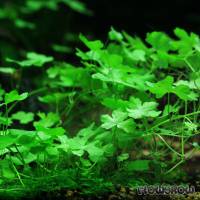



This small, delicate Hydrocotyle is highly popular with aquascapers especially from Asia, and is known under diverse names there. It was hardly known in Europe until recently. However, it was imported from Thailand to Italy in 2008 under the name Hydrocotyle sp. "Japan", and from Japan to Germany in 2010.
It is most similar to Hydrocotyle sibthorpioides, however, there are still some differences, the most prominent of them being the deeply indented three- to five-lobed leaves. Not only its nice leaf form that resembles somewhat of clover, but also the fact that it is more undemanding than Hydrocotyle sibthorpioides commonly available in trade. It is also a faster grower and has a more creeping or overhanging growth habit. Under lots of light and CO2 as well as an ample supply of nutrients it grows very fast and may even tend to get invasisve. Under lower lights it grows more slowly, and its sprouts have a more upright than creeping growth habit.
Its fast growth will surely be the reason why it won't remain a rarity in Europe for long.
Its exact origins and species of this Hydrocotyle are still unclear. In the hobby it is known under the names Hydrocotyle tripartita, H. spec., H. sp. "Australia", H. sp. "Japan" or H. maritima. If it really originates from Australia, the name H. tripartita is probably correct. However, it could only really be identified by means of flowering and fruiting emersed plants. Similar groups of Hydrocotyle also occur in East Asia, e.g. H. sibthorpioides var. batrachium (South China, Taiwan, Philippines, Vietnam) and H. yabei (Japan), which is also considered to belong to H. sibthorpioides. The name "Hydrocotyle maritima" is incorrect. According to the online version of "Flora of China" this name is a synonym of Hydrocotyle ramiflora, which differs considerably from the plant we keep in our tanks.
- To be continued -
<a href="https://www.flowgrow.de/db/aquaticplants/hydrocotyle-cf-tripartita" target="_blank"><img alt="Hydrocotyle cf. tripartita" title="Hydrocotyle cf. tripartita" src="https://www.flowgrow.de/db/widget/aquaticplants/hydrocotyle-cf-tripartita" /></a>
[url=https://www.flowgrow.de/db/aquaticplants/hydrocotyle-cf-tripartita][img]https://www.flowgrow.de/db/widget/aquaticplants/hydrocotyle-cf-tripartita[/img][/url]
[widget=aquaticplants/hydrocotyle-cf-tripartita]Hydrocotyle cf. tripartita[/widget]